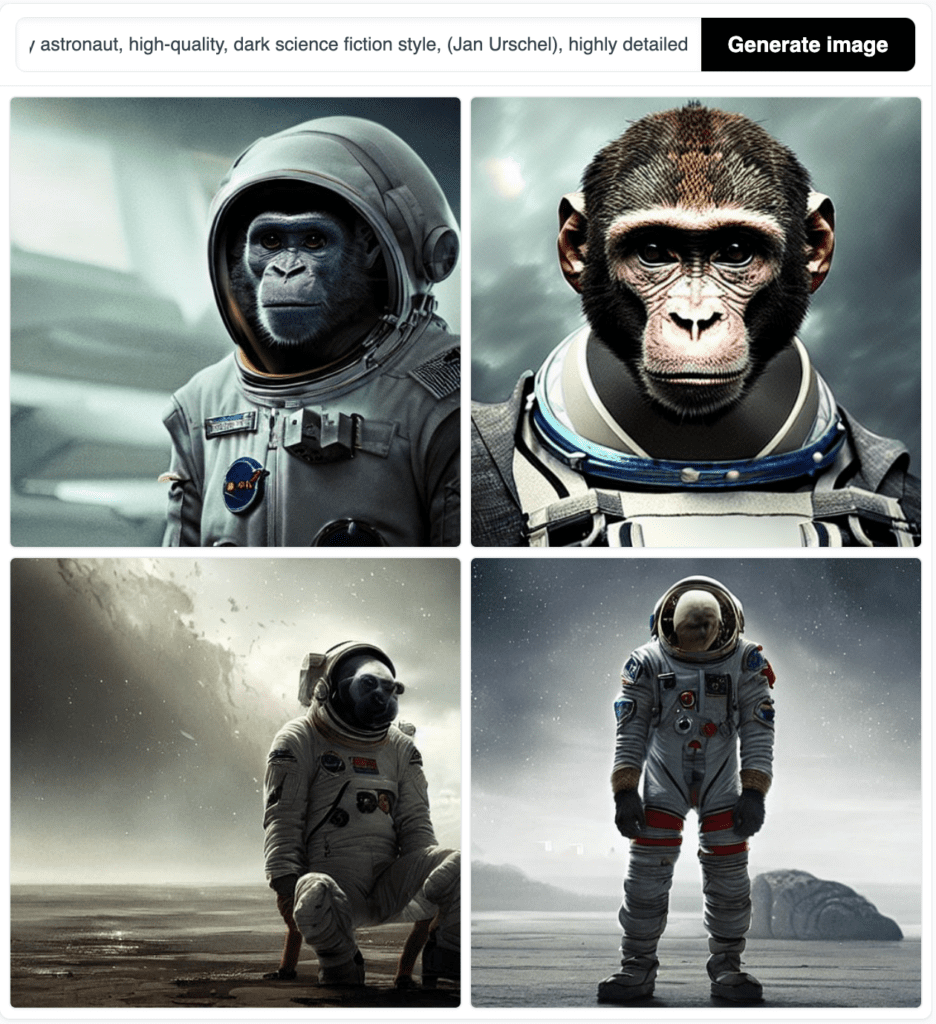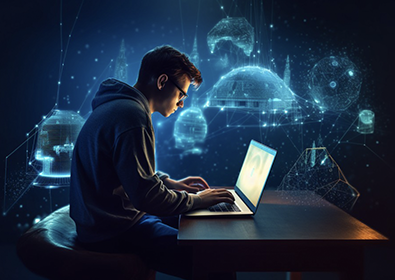AI art prompts have revolutionized the creative process, empowering artists and creators to push the boundaries of artistic expression like never before. In this guide, we’ll dive into the art of crafting effective AI art prompts, exploring the structure, strategies, and tools that will take your creativity to new heights.
Whether you’re using ChatGPT or AI image generation tools, we’ll show you how to create prompts that inspire and captivate! From understanding the key components of a good prompt to exploring advanced techniques and resources, you’ll become a master at generating AI art prompts that yield stunning results.
Follow along: Want to turn your reading session into a crash course? Take a look at our list of The Ultimate AI Image Generators in 2023, pick your favorite, and learn the art of crafting prompts that turn your “ok” images into “wow” masterpieces! Each AI model has its own unique way of working with prompts (and each attempt will be different, too). Get ready to experience a roller coaster of creativity!
The Structure of an AI Art Prompt:
Get your AI art prompts on point! A well-crafted AI art prompt consists of several key elements that guide the AI model in generating the desired image. Here is the general structure of an effective AI art prompt, in order of writing:
[image content/subject, description of action, state, and mood],
[art form, style, and artist references],
[additional settings, such as lighting, colors, and framing]
Remember to use commas to separate elements in your prompts. It helps the AI model understand what you want and keeps things clear for you too.
How Long Should Your Prompts Be?
No strict rules here! Midjourney does well with 60-word prompts, while Stable Diffusion prefers ones under 380 characters, and DALL-E 2 gives you 400 characters to play with. Don’t overload them, though; too much might confuse the AI generators. Play around to find the sweet spot!
Crafting the Right Language
Use vivid details and precise language for more predictable outcomes. If you prefer a poetic or abstract approach, be ready for surprises! Feel free to blend styles as per your creative vision.
As you gain experience, you can explore prompt length, style, and structure. But first, let’s thoroughly examine each component to master those AI art prompts like seasoned pros!
Part 1: Image Content:

Generated with Stable Diffusion
To begin, clearly state the subject or content of the image you want to generate. Be specific and descriptive, providing details about the subject’s actions, state, and mood. For instance, you can request a picture of a cityscape at sunset or a misty forest at dawn.
Beyond the subject, consider adding:
- Actions: Depict what the subject is engaged in (i.e., dancing, reading, or soaring through the sky).
- Manner: Illustrate how they perform these actions (i.e., gracefully, anxiously, or confidently).
- Mood: Infuse the image with emotion and ambiance using expressive descriptions (i.e., a mystical moonlit forest, thrilling stormy seas, or serene sun-kissed meadows).
Remember, the more specific and detailed your input, the more fascinating and nuanced the result. Keep in mind that different AI models interpret inputs uniquely based on their training and configuration. So, have fun experimenting and uncovering the diverse possibilities each model offers!
Part 2: Art Form, Style, and Artist References:

Generated with Stable Diffusion
Specify the desired art form or medium for the image, such as photography, painting, illustration, or digital art. Additionally, you can reference specific art styles or artists that you want the generated image to emulate. This helps set the aesthetic direction and influences the overall look and feel of the artwork. For example, “A serene countryside, impressionist oil painting, reminiscent of Monet’s landscapes.”
Part 3: Additional Details:

Generated with Stable Diffusion
Include any additional details or settings that you want to be incorporated into the image. This can involve aspects such as framing, lighting conditions, color schemes, level of detail or realism, and even specific parameters for certain AI models. The more specific and detailed your instructions, the more likely you are to achieve the desired outcome. Experiment with different combinations to create unique and compelling prompts.
Crafting Effective AI Art Prompts:
Now that we understand the structure of an AI art prompt, let’s explore some strategies and considerations for crafting effective prompts that yield impressive results:
- Be Specific and Vivid: Use concrete language and vivid details to paint a clear picture in the AI model’s “mind.” This helps the model better understand your vision and generate more accurate and engaging images. Avoid ambiguity and provide explicit instructions wherever possible.
- Experiment with Language Styles: Depending on your objectives, you can play with different language styles in your prompts. Vivid and concrete wording tends to produce more predictable results, while poetic or abstract language can lead to surprising and unique outcomes. Mix and match styles to achieve the desired artistic effect.
- Iterate and Refine: Creating effective AI art prompts often requires experimentation and iteration. Don’t be discouraged if your initial prompts don’t produce the desired results. Refine and tweak your prompts based on the feedback and outcomes you receive, gradually honing your skills at crafting compelling prompts.
- Explore Advanced Tools and Techniques: Take advantage of advanced AI art prompt tools and techniques to enhance your creative process. Consider using image-to-image prompts, AI outpainting, or training your own AI image model. These approaches provide additional flexibility and control, allowing you to achieve more customized and tailored results.
Resources for AI Art Prompt Ideas:
Finding inspiration for your AI art prompts can be a great starting point for your creative journey. Here are some resources where you can discover AI art prompt ideas:
- Neural.love‘s Public Library: Browse their collection of images and corresponding prompts to gain insights and inspiration for your own prompts.
- Midjourney’s Discord Channels: Join the Midjourney Discord community to engage with other creators, exchange ideas, and explore a wealth of AI art prompts shared by fellow artists.
- Lexica for Stable Diffusion Prompts: Lexica is a website that offers a curated collection of prompts specifically tailored for Stable Diffusion. It provides a valuable resource for discovering new and intriguing AI art prompt ideas.
Writing effective AI art prompts is both an art and a skill that can unleash your creativity and yield stunning results. By understanding the structure of a good prompt, experimenting with language styles, and exploring advanced tools and techniques, you can craft compelling prompts that inspire and captivate.
Embrace the limitless possibilities of AI art generation, and let your imagination soar as you embark on a journey of artistic exploration and innovation!
Download AppRelated Resources
10 Best AI Avatar Generators to Try
Generated via Midjourney Discover the top AI avatar generators and create your unique digital persona with ease. In our rapidly…
Read MoreAI Joins Shutterstock’s Image Library
A Brave New World of Creative Imagery Credit: Shutterstock In a world that's bursting at the seams with visuals and…
Read More6 AI Photo Editing Apps You Need to Know About
Enhance Your Photos in a Snap Generated via Midjourney Photography enthusiasts have experienced their fair share of struggles when it…
Read MoreAI Gaming: A New Era of Play
Transforming Gaming as We Know It [video width="1600" height="900" mp4="https://aiartmaster.co/wp-content/uploads/2023/10/video-game-loop-1.mp4" loop="true" autoplay="true"][/video] Video Credit: Jitao Zhou/Rikkyo University Gaming…
Read MoreReal or Fake? How to Spot an AI-Generated Image
Detecting Digital Image Forgeries In today's world, AI is advancing so rapidly that distinguishing real photos from fake ones can…
Read MoreThe 10 Top AI Trends for 2024
Generative AI Trends for 2024: Shaping a New Era As we kickstart the year 2024, it's time to prepare for…
Read MoreTraditional Art Vs Digital Art: Canvas Vs Code
In the vast realm of artistic expression, two mediums have emerged as prominent contenders: traditional art and digital art. While…
Read MoreMachine Learning Core Components
Representation: Translating Data into Meaning Data representation is the linchpin of machine learning. It's the intricate process of converting raw,…
Read More

